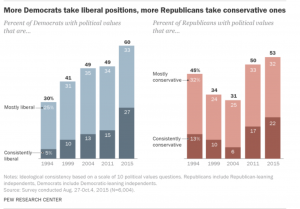Are Divides Within Political Parties Effecting Popular Sovereignty?
When reading chapter 9 regarding political parties I found myself caught up in the consequences that arise from divisions within political parties. Though America is a strong, two party system, the divisions within the Democratic and Republican parties have actually been increasing over time. When reading further I was not only intrigued by the lines that divided the groups within their own parties, but also by the consequences that come from these increasing divisions within party lines. In a time when our government’s political parties are exceedingly polarized from one another, what does it say about the fact that the parties themselves are becoming more divided?
“While differences between Democrats and Republicans have become more pronounced, and while ideological and policy cohesion within the parties has been increasing, especially in the GOP, important disagreements within each party remain… parties are not perfectly unified.” (Greenberg and Page). Though as a country party polarization has increased, party unity has decreased. The graph below from ‘The Pew Research Center’ depicts how over time, party polarizing has increased.
Though it is apparent that since 1994 through 2015 there has been a pretty steady polarization of political views—meaning that Democrats take more liberal views and Republicans take more conservative ones, it is not enough to simply take that information at face-value. When looking at this graph, I would assume that because both parties are moving towards stronger liberal/conservative views, that that would reflect the political attitudes of each unified party, however, I found the opposite.
When looking specifically at the Republican Party, for example, one can see that fissures have existed for some time. These fissures, from a broad perspective, mainly arise from what Dan Balz and Jon Cohen from the Washington Post call the five types of Republicans. “The Post-Kaiser analysis reveals five distinct types of Republicans…Four are familiar elements of the GOP coalition: “Tea Party Movement Republicans,” “Old-School Republicans,” “Religious Values Voters” and “Pro-Government Republicans…” The fifth, a group we label “Window Shoppers,” are self-identified Republicans who in many respects seem out of place in an increasingly conservative party” (Balz and Cohen). With so many divisions within one party, it is hard to see how there are solely two main political parties within our government today.
When looking specifically at the Democratic Party, there are also divisions, however, they are less pronounced. According to Balz and Cohen, there exists four types of Democrats (all of whom are mainly divided on the issue of Gay marriage). “Urban Liberals — the most traditionally liberal of the groups — are nearly three-quarters white and by far the most educated and highest income earners among Democrats…The God and Government contingent is two-thirds nonwhite and far more apt than two of the five Republican groups to go to religious services at least once a week” (Balz and Cohen). There also exists “Agnostic Left” (who seldom go to church and believe there should be a high degree of separation from church and state) and the “DIY Democrats” (who advocate for a stronger federal government). We can see how these separations apply today when looking at the Democratic primary between “centrist” Hillary Clinton, and the incredibly liberal Bernie Sanders. Many scholars think that Clinton’s centrist Democratic stance may have lost her enthusiasm for the 2016 general election campaign (Greenberg and Page).
When looking at these divides within each party, it is interesting to see how our government is still so set upon its two- party system. With so many opposing views, even within party lines, does that not portray that our country may need to rethink its two-party system? Political parties are “meant to carry out a number of functions that make popular sovereignty and political equality possible,” however, when both the Democrats and the Republicans have major splits within each party respectively, how can their party really promote popular sovereignty when there is no true majority with the increase of fissures within parties?
Citations:
Balz, Dan, and Jon Cohen. “Big Gulf between Parties, Divisions Within.” The Washington Post, WP Company, 18 Aug. 2012, www.washingtonpost.com/politics/big-gulf-between-parties-divisions-within/2012/08/18/f5ee15d4-e31a-11e1-ae7f-d2a13e249eb2_story.html?noredirect=on&utm_term=.91b776036b55.
Drutman, Lee. “Political Divisions in 2016 and Beyond.” Democracy Fund Voter Study Group, 30 Jan. 2018, www.voterstudygroup.org/publications/2016-elections/political-divisions-in-2016-and-beyond.
Greenberg, Edward S., and Benjamin I. Page. The Struggle for Democracy. Pearson, 2018.
